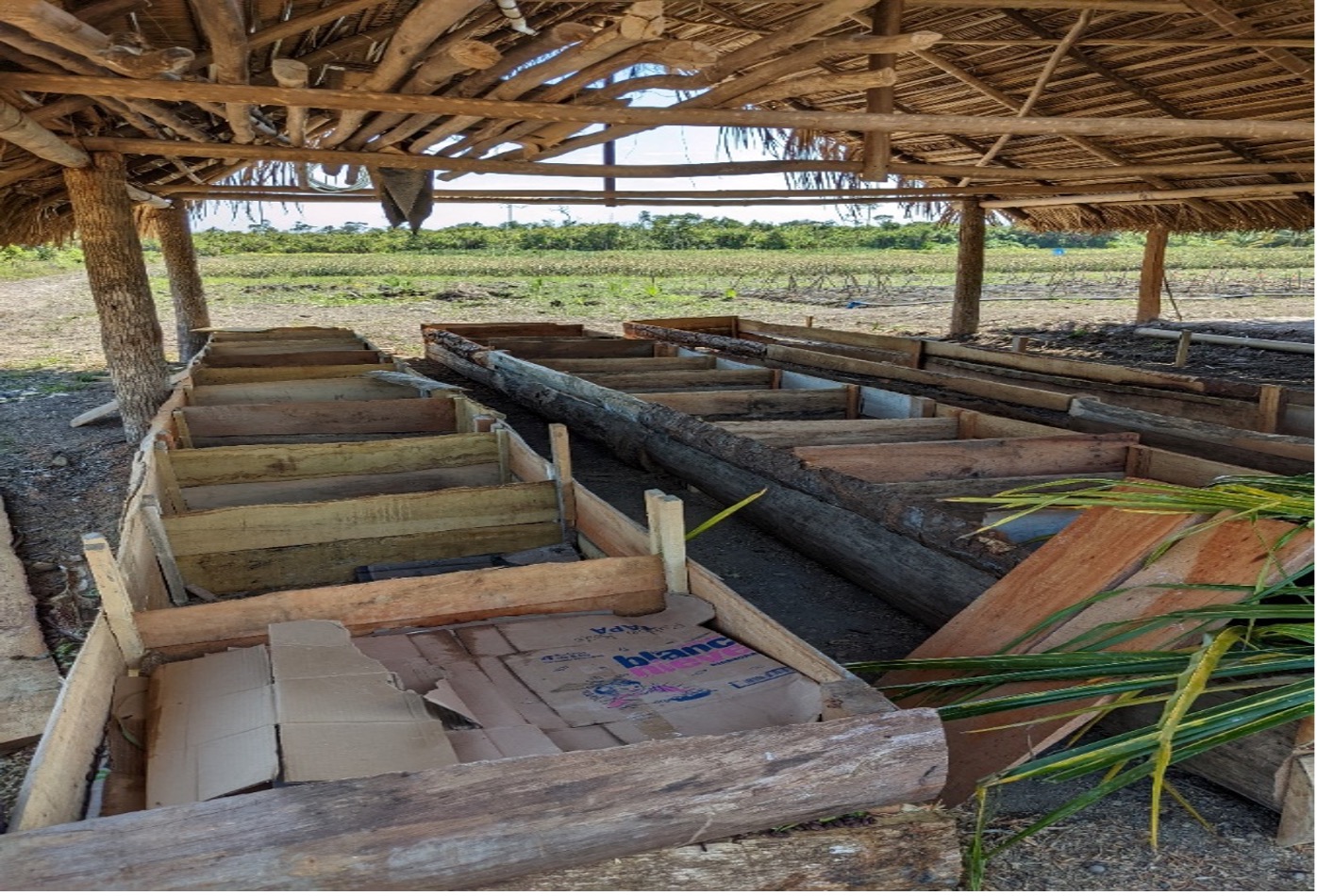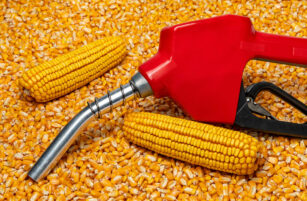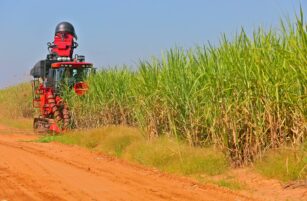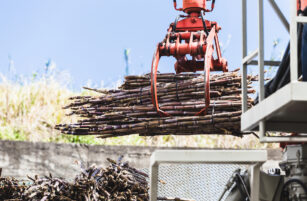Insight Focus
- Aim is to cut chemical fertiliser use, given high prices due to Ukraine war.
- Vermicomposting, Bokashi methods being used.
Vanilla is an epiphyte which means it grows on another plant, also known as a tutor tree like madre de cacao, moringa, mahogany, and even pine. In fact, vanilla will grow happily on a concrete or PVC post or a metal stake, as long as its roots can feast on compost such as leaf litter lying at the base of trees in a rainforest rather than directly in soil. Orchids are epiphytes too.

Given that we are in the middle of planting 22 acres of vanilla on our farm in Belize, we need truckloads of compost, which has become a greater logistical challenge than planting around 30,000 tutor or support trees and 30,000 vanilla plants in a country where gasoline costs nearly USD 7 a gallon.
Mulch from Woodchipper

There’s a couple of ways we are generating compost material. The first and my current favorite is using a woodchipper to process pruned planting material, mostly madre de cacao, plantain, cocoa, pineapple crowns, coconut husks, downed tree branches and the like. Right now, we apply that directly to the base of the tutor tree mixed with some biochar. Strictly speaking it’s mulch, not compost.
But that’s really only blocking weed growth and preserving moisture. It isn’t really available as nutrition to either the tutor tree or the vanilla. That’s fine at the moment as we don’t have our tutor trees or vanilla fully planted. We’re just trying to cut down on mechanical weed control with a weedwhacker as well as reducing irrigation during the dry season.
Getting Mix Right
What would be ideal is that moist brown crumbly compost you see on gardening shows that have been aged for up to two years. I wish. Nevertheless, we have set up a composting area where we are working out the optimal way to make a fast compost. This involves working out the best mix of browns and greens as well as heat and water.
Browns are the carbon or carbohydrate-rich materials. They are the food source for all the organisms that work with the microbes to break down the contents of the compost pile. They also add bulk and crevices to allow for airflow in the pile. Browns are things like sawdust, cardboard, cocoa pods, leaf clippings and wood chippings.
Greens are the items that are rich in nitrogen or protein and add the fuel to heat up the pile and break down, mostly vegetative food waste. We mostly use grass clippings, as well as reject pineapples and lettuce but are increasingly picking up waste from our local fruit and vegetable stand after we make deliveries.
The idea is that with the correct ratio of browns and greens you achieve a carbon:nitrogen ratio that starts to heat up and break down rapidly. In the ideal world it’s about 4:1 but it’s mostly about what you can get close by. There are a million subreddits and Instagram influencers with their theories on the right ratio, but this number seems to work for us.
So, the browns and greens are mixed and piled up, and then we add a shovelful of compost from an older pile to introduce the micro-organisms that are going to do all the work. We make sure all the foodstuff is fully mixed in to deter rats, birds (and our dogs) and wet it down to kick start the process.
After a few days, the pile heats up to over 60 degrees Celsius and about every two weeks we turn it to stop it becoming anaerobic, which makes it stink. In the dry season we wet it down to keep the composting going and to stop dust becoming a problem. As the process continues the pile starts to shrink, and in our climate, we have some fairly decent compost in about two months.
Worming Away

We have also started a small vermicompost operation using red wiggler worms, not the earthworms we find all over the farm. Red wigglers are more voracious eaters (but picky). We are still working on the right mix of bedding, watering, feeding and ant control but plan to scale that up after a few more trials. Vermicompost is composting gold.
Bokashi composting
This year we also started Bokashi composting. This uses an anaerobic process to rapidly break down any food scraps including meat and dairy and has been a gamechanger for us in keeping pests and dogs out of our garbage.
You take two plastic buckets and put a tap in the bottom of one, then drill holes in the bottom of the other. Stack them on top of each other (tap bucket at the bottom) and put a cotton rag over the holes in the top bucket. Then start to fill the top bucket a few inches at a time with food scraps. We then sprinkle Bokashi mix on the scraps, compress the compost with a plunger and put a lid on the top bucket. Every few days empty the liquid that has accumulated in the bottom bucket, dilute it, and put it on your plants.
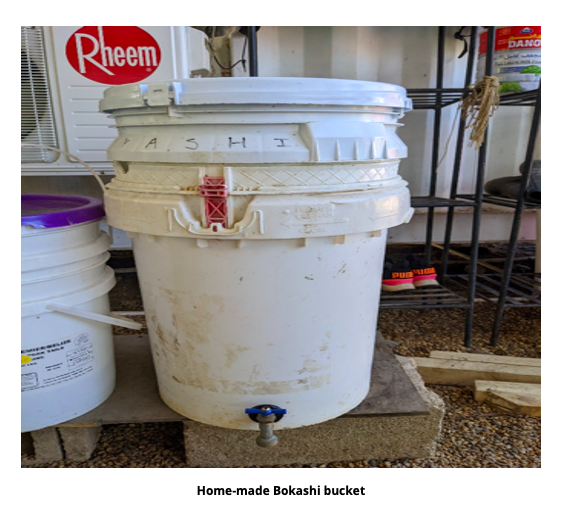
The Bokashi mix is a blend of mostly Lactobacillus bacteria growing on sawdust in our case. Anybody with time can make their own – just go to YouTube. It can break down food scraps very rapidly. After the bucket is full, we let it stand for 2 weeks and then mix it with our compost piles as a starter.
By using Bokashi, our regular garbage now no longer stinks, and we aren’t paying to haul it away to the tip where it will generate methane. The other plus is that our workers are now starting to see the benefit of all this garbage control and are beginning to test it in their own homes, where burning it all is still the norm.
I’m still struck by the cultural taboos here around waste. It’s just thrown anywhere, especially in creeks and on the sides of the road. It will take a massive campaign to educate Belizeans on separating and managing waste and to get them over the “ick” factor.
Goal to Reduce Chemical Fertilizer Use
The whole point of all this composting is to generate bioavailable nutrients for our shade trees and vanilla. The end goal for us is to reduce ground fertilizer applications so as not to mess with the soil biome that can provide a lot of the nutrients, and to save money on chemical fertilizers (thank you, Russia!). It really does work. We will continue to use very diluted foliar fertilizer which plants can uptake very rapidly and which needs a lot less labour to apply.
